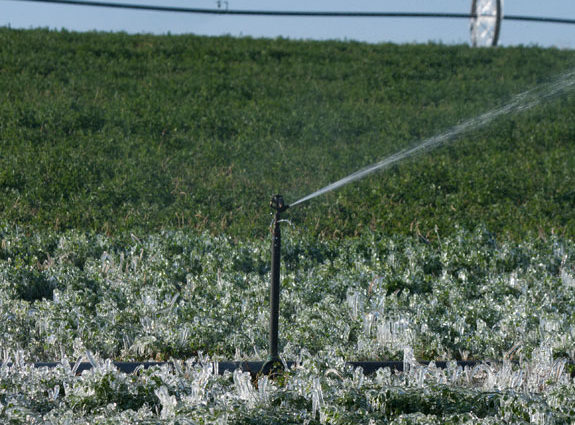Time spent now will prevent damage and lead to a better start on next year’s irrigation season. Inspection of the system now allows you to make improvements and repairs in the less costly off season and get irrigation problems out of the way for spring planting season when everyone is busy.
Park pivots in safe location
When choosing a location to park the system for the winter, consider the three most common potential sources of damage: Wire theft is less likely in a visible but inaccessible area of the field; wind damage is less likely if pivot points into or away from the wind direction rather than perpendicular to wind direction; and squirrels and other rodent damage to span wire is rare when pivot are a few 100 feet from the tree line.
Drain pivots
Most of the currently designed pivots have automatic frost drains that drain the main overhead pipe. Plugged automatic frost drains can lead to major repairs if not caught in a fall inspection. Rock traps need to be cleaned and drained.
Pivot supply lines, end gun supply and hydro control hoses are often installed to allow drainage but the hose may sag and hold water which can lead to damage. Remember to cap all large openings into the system to prevent bird nesting.
Drain travelers and big guns
Travelers and stationary big guns often have portions of their system that may hold water. Drain and roll-up hoses, unhook and drain ends couplers and drain water drive piston and motors that may be damaged by freezing.
Pump down or drain underground pipelines
Most underground pipelines are buried deep enough to prevent freeze damage but often require pumping or draining enough water from them to empty the upper portion of Z-pipe risers and pump manifolds.
This is typically done by purging the system with air or modifying a fertilizer transfer pump to pump system at its lowest outlet or inlet points. Remember to cap all pipe inlets and outlets to prevent rodents from entering.
Drain the pumping plant
Drain pumps and manifold to the lowest point they can hold water. Replace brass drain plugs if damaged. Good designed pumping installations will be easy to drain without striping drain plug threads or the need of air purging.
Inspect gauges, supply and control wire for need of repair. Service engine with attention to engine oil, bearing and seal lubrication. Check cooling system for adequate anti-freeze level and concentration. Drain fuel tank to reduce water accumulation in fuel tank and potential theft.
Inspect and lock down electrical power supplies
Locking down electrical power supplies help prevent vandals from turning wells and pivots on midwinter and minimize potential electrical system damage.
Inspect each electrical box in the system from power supply to the last pivot or disconnect on system line for damage and holes that may be access for rodents. Now is an excellent time to inspect grounding system and test resistance.
Create a winter work list for each system
While it is fresh in your memory, list the improvement and repairs needed for each system. As you are inspecting and winterizing your system, add any other areas needing attention to the list of repairs needed.
Assign the repair to someone whether it is your people or the local irrigation dealer repair crew, the sooner it gets into the plan the better and more efficient it can be.
For more irrigation management information visit our website: www.msue.msu.edu/stjoseph FG
Lyndon Kelley
Irrigation specialist
Michigan State University Extension
kelleyl@msu.edu
—Michigan State University Extension News for Agriculture website










